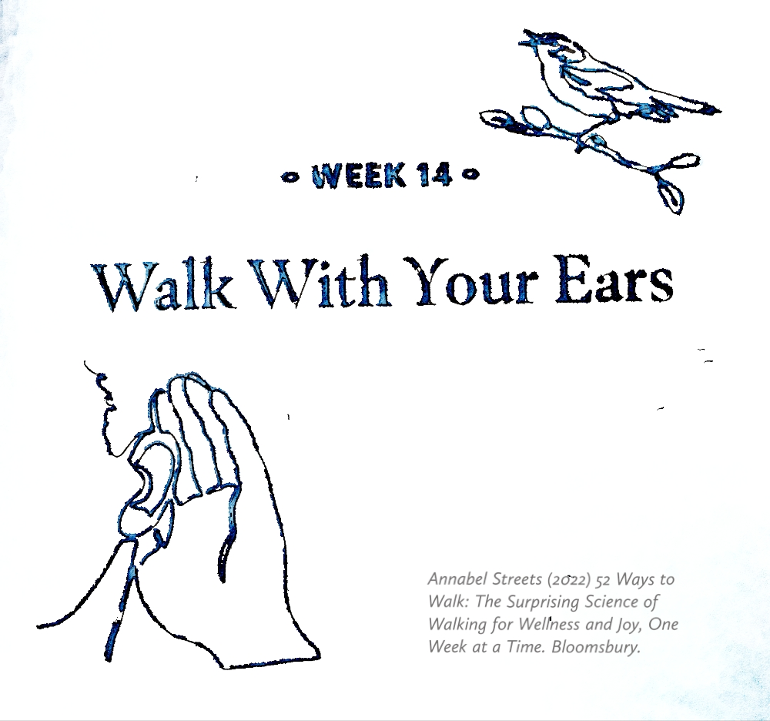Happy April! This month’s walking challenge:
★★★Take a walk for your ears, including applying some intensive listening strategies★★★
☆☆☆ And let us know about your audio-rich adventures by posting here on our Active10 forum using the hashtag #EarWalk” in your title ☆☆☆
For this audiophile, this is another intriguing chapter from Annabelle Street. To use one’s ears differently, to actually really listen to your environment, sounds like heaven to my ears… or rather… or sounds like heavenly nature.
I’ll start this challenge with some of her tips for having a good “walk for - and with - your ears”:
- First, my tip: don’t stop taking your headphones along. See the last tip
- If you can, head out alone to your listening walk
- Choose less populated areas
- Avoid the usual trails or key beauty spots – “this walk is for your ears rather than your eyes.”
- Cupping your ears often helps to intensify what you hear
- Close your eyes at times. It allows you to focus on what you hear
- Use your smartphone recorder to make your own natural soundscape recording, and use it for the next walk
- Try a very different “ear-led wander”: download to your smartphone some guided walking apps that focus on listening walks (e.g. the app Echoes Interactive Sound Walks)
- Combine it with a bird walk and try to identify birds through their birdsong
I especially like the tips that include sound or recording apps. That is completely up my street. I was already contemplating taking a professional microphone and some good headphones for a walk, as it intensifies all sounds even more than just cupping your ear does.
The chapter in Annabel Street’s book, though, covers some other aspects.
It suggests that there is evidence that natural soundscape naturally relaxes the brain much more than traffic noises or even classical music. And these natural soundscapes don’t just affect the brain, but through the brain, they also affect heart rate, muscle relaxation, and regulation of intestines and glands. A sort of full-body, active relaxation.
Additionally, when listening to natural sounds when working - ideally outside in nature - compared to listening to music or traffic noise, one’s focus is improved. There goes my love for listening to music when walking or running!
So tuning in to the tussle of the trees, the swirling of the water, and the melodies of birdsong might just help solve that real-world conundrum that had one worried.
On the opposite, city and traffic noise is also actually proven to cause anxiety. It affects our pulse, heart rate and blood pressure, as well as our deep sleep. So one remedy is to walk somewhere where there is nature, somewhere “naturally quiet”, where we can listen to the natural world.
The National Trust commissioned a study some years ago that found the following sounds bring the greatest pleasure:
- Birdsong
- A running stream
- Rustling tree leaves
- Silence
- Twigs snapping underfoot
- Animal noises
- Wind whistling through the trees
- Rainfall on leaves
- Conkers hitting the ground
- Squelching mud
So for this month’s challenge, we take another of Annabel Street’s challenges on, and we will take our ears out for a walk.
So our challenge in short:
★★★Take your ears out for a walk and let THEM lead the way! ★★★
☆☆☆ And let us know about your audio-rich adventures by posting here on our Active10 forum using the hashtag #EarWalk” in your title ☆☆☆
= * = * = * = * = * = * = * = *
Readings from
Annabel Street (2021): 52 ways to walk. The surprising signs of walking for wellness and joy, one week at a time. Chapter 14 : Walk with your Ears
= * = * = * = * = * = * = * = *
For reference, our first challenge from January is here
★ January Challenge - Walk in the Cold
healthunlocked.com/active10...
★ February Challenge - Take a 12-min Walk
healthunlocked.com/active10...
★ March Challenge - Take a City Smell Walk healthunlocked.com/active10...

